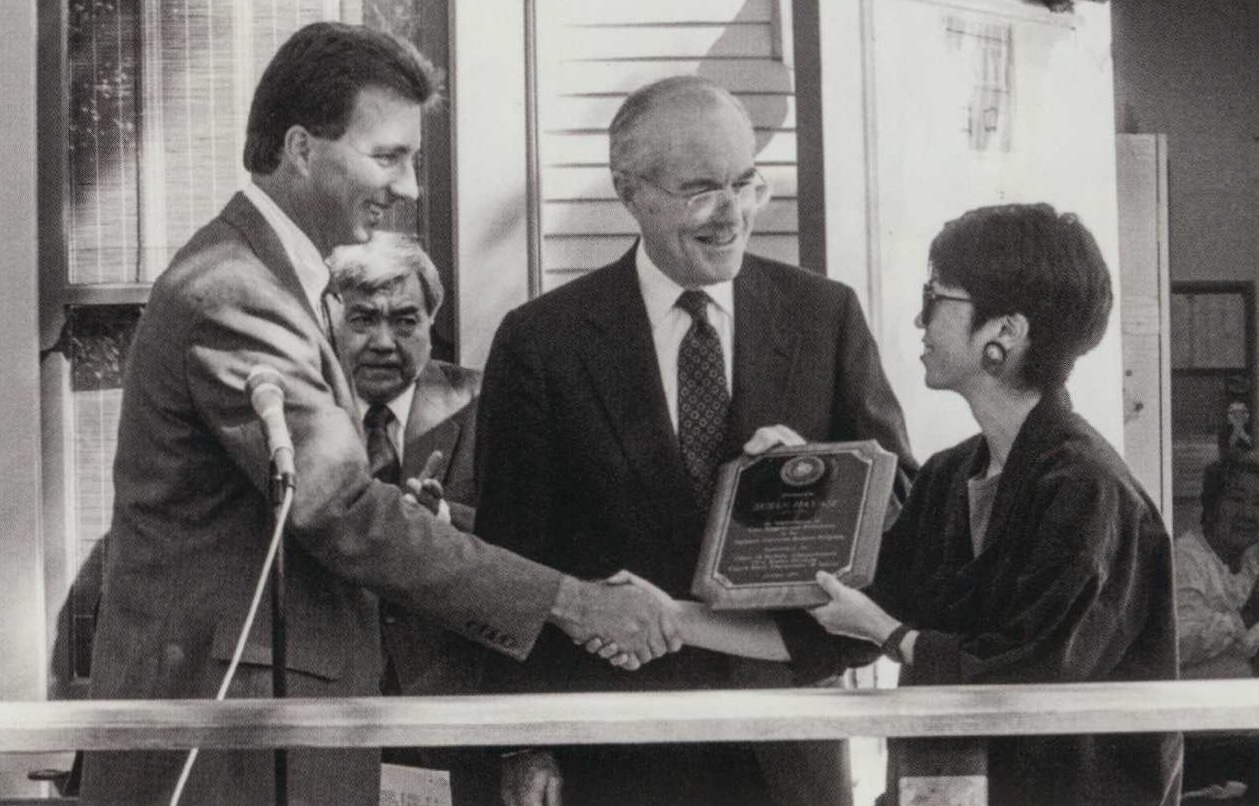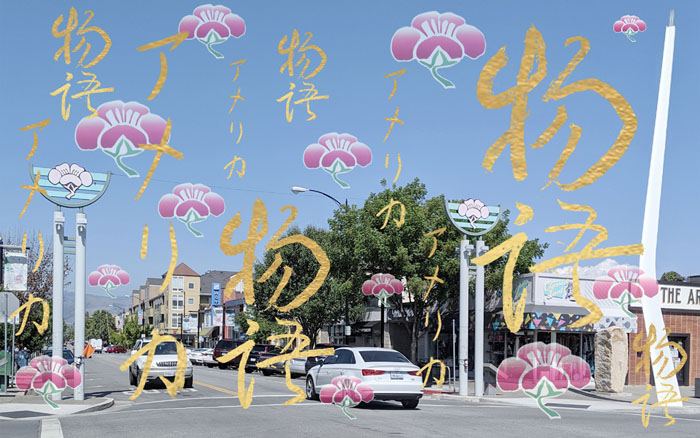Tom Izu and Susan Hayase: Healing through Collective Action
- Date
-
May 28, 2024
- Location
-
De Anza College
- Interviewers
-
Mae Lee and Karen Wang
- Interviewees
-
Tom Izu (1958 - ) and Susan Hayase (1956 - )
- Transcript
Building Asian American Political Consciousness
Tom and Susan were leaders in the Japanese American redress movement of the 1980s. However, as the movement achieved its goals and began to wind down in the 1990s—and amidst the loss of their parents and a changing political climate—they turned their attention to the future. Concerned that the Japanese American community would "drift to the right" during the Reagan era of conservative backlash, Tom and Susan sought ways to remain engaged with progressive political movements. They used their platform from the redress movement to not only put forward a particular political view of its legacy, but envision a future where Japanese Americans actively contribute towards building a multiracial democracy.
Japanese Americans had a political role to play in this country, along with other people of color.
- Susan Hayase, oral history, 2024
A Sansei's Journey to Redress
Growing up as a Sansei (third-generation Japanese American) in California, Susan always knew that her parents had been sent to camps during World War II. And even from a young age, she noticed how she and her parents were treated differently as one of the few Asians in a predominantly White community.
One day, Susan came across "Citizen 13600" by Miné Okubo, a firsthand account of Japanese American incarceration. Reading the book made her realize what the camps actually were—prison camps where Japanese Americans were detained because of their race. She also began to connect her parents' fear, caution, and reluctance to stand out with the fact that, after leaving camp, many Japanese Americans were told to keep a low profile and avoid congregating in large numbers.
With this newfound knowledge, Susan approached her third-grade teacher after school. As the teacher cleaned the board, Susan said, "Miss Gormley, my parents were in a prison camp during World War II." Without hesitation, her teacher replied, "That didn't happen."
That moment was transformative. Her teacher's denial of her family's experiences shook her to the core, but also fueled her determination to confront the alienation and loneliness caused by systemic racism—what she later described as a "desire to become whole." Many years later, she became a founding member of the National Coalition for Redress/Reparations (NCRR), a nationwide organization that helped fight for and ultimately win reparations for Japanese American incarceration during World War II—affirming, without a doubt, that it happened, and that it should never happen again.

Susan accepts an award from the Office of Redress Administration when the first Issei redress checks were delivered in the 1990s. Photo courtesy of Nihonmachi Outreach Committee (NOC) via "San Jose Japantown: A Journey."
For me, redress/reparations wasn't just "an issue" that I could choose to be involved with or not. It was something that consumed me in my young adulthood because it offered the possibility of connection to the community from which I had been purposely estranged by government policy.
- Susan Hayase, "A Personal Reflection: Japanese Americans in the Age of Reparatory Justice," East Wind ezine, 2023
Shifting the Narrative toward Multiracial Solidarity
In 2014, when Tom was Director of the financially struggling California History Center, the center received a large grant that not only helped keep it afloat but also led to the creation of the Audrey Edna Butcher Civil Liberties Education Initiative. This funding prompted Tom to consider how to present Japanese American incarceration in a way that would remain relevant to both students and the broader community. In doing so, he began reconnecting with local organizations, including the Japanese American Museum of San Jose (JAMsj).
At the time, Tom noticed that JAMsj was leaning toward an interpretation of Japanese American history as exceptional or disconnected from other communities of color—the model minority narrative. He believed this was a mistake, particularly given the rising wave of anti-immigrant rhetoric. He thought that if Japanese American history—especially the incarceration during World War II—was to remain meaningful, it had to be understood as part of a larger struggle for justice.
In addition, around this time, increasing attacks on immigrant communities led K-12 teachers to turn to the museum for resources on race and immigration. This led Tom to ask: "How do Japanese Americans fit into broader patterns of immigration?" He saw an opportunity to help shift the museum’s narrative toward one that emphasized solidarity with, rather than isolation from, other communities of color.
This led Tom and Susan to examine historical relations between Japanese and Mexican American communities—two groups that had often been placed in competition, particularly among farmworkers. These efforts culminated in a panel at JAMsj called "I Never Saw My Father Again," which connected Japanese American incarceration to the Mexican Repatriation of the 1930s, in which over one million Mexican Americans were scapegoated and deported due to the Great Depression.
The panel highlighted the shared trauma of family separation between the Japanese and Mexican American communities. Jiro Saito, a former redress activist, shared how his father had been arrested by the FBI after Pearl Harbor, taken away, and later died in custody when Jiro was only three years old. Dr. Francisco Balderrama of CSU Los Angeles spoke about the mass deportation of Mexican Americans in the 1930s, noting that the majority of those deported were children born in the United States.
Tom reflected, "Some of the Mexican Americans who came were very emotional because they had their own stories [about family separation]...and alternatively, that a big impact on some of the Japanese Americans there, because they could understand how close their feelings are to this other person."

Mexican immigrants being escorted back across the border. Photo courtesy of Getty Images via History.com

Japanese Americans board a train bound for the internment camps. Photo courtesy of Wikimedia Commons.
Redress 2:0: Unfinished Business
In the years leading up to the 2016 presidential election, Tom and Susan were nearing retirement. However, they saw parallels between the rising wave of anti-immigrant and anti-Muslim sentiment and what Japanese Americans had faced during World War II. The redress movement of the 1980s had aimed to ensure that such things would never happen again, yet history was repeating itself.
They started calling up their old friends from the redress movement and asking them, “What are you going to do with the rest of your life?” With so much at stake, they believed those who were still able should step up.
A lot of people think that their politics is just, "I have this opinion in my head, and that's my politics." But...you have to do something, and you have to do something collectively with other people.
- Susan Hayase, oral history, 2024
After Trump’s election, Tom and Susan attended a public Japanese American Citizens League (JACL) meeting to discuss how to respond to his administration’s policies, including the Muslim ban. During the meeting, Susan raised her hand and said, “Anybody who wants to help form the San Jose Nikkei Resisters, come out to the patio” A dozen people showed up, and SJNR was born.
At the time, Japanese Americans weren’t mobilizing as a unified force against Trump’s immigration policies. But Tom and Susan believed it was essential for Japanese Americans—and Asian Americans in general—to take a collective stance. The core of SJNR consisted of the redress movement veterans, but it also began to attract Sansei who hadn’t been involved before, along with younger activists.
Countering the model minority narrative—that some people of color are better than others—was central to their message. In the process, they also learned about the global reparations movement—led by Black and formerly colonized communities—which emerged after Japanese American redress. This expanded their understanding of reparations beyond financial compensation to include non-repetition and healing. They realized that the fight for justice was far from over—redress was unfinished business. More than just showing up in solidarity, Asian Americans had something to learn and something to gain from the struggle for a multiracial democracy.
Hidden Histories of San Jose Japantown

Above: Augmented reality art created for the Brush the Sky project in 2019, a prototype for the Hidden Histories project. Photo courtesy of Hidden Histories website.
While Tom and Susan's activism was connected to global issues, they believed that local, place-based history were essential to building a politically engaged community. In particular, they saw the importance of grounding their organizing work in San Jose Japantown in what they called the "hidden histories" and struggles of the neighborhood.
This led to one of their most significant projects, which came through an unexpected grant from the Knight Foundation that allowed them to use augmented reality to illustrate the layered histories of San Jose's Japantown and its connections to Heinlenville Chinatown and Pinoytown. By training local artists and designing the technology to be accessible, they created an interactive experience that not only engaged the public but also provided a platform for voices like Connie Young Yu and Robert Ragsac.
Around this time, a political debate emerged over the naming of a new park in Japantown. While some residents favored "Sakura Park," Tom, Susan, and others used platforms like the Hidden Histories project to advocate for naming it "Heinlenville Park" in honor of the Chinatown that predated Japantown. They argued that acknowledging this history would not diminish Japanese American identity, but strengthen it by bringing other communities into the collective story. Their efforts paid off—the park was ultimately named Heinlenville Park, and today, the community widely recognizes its significance.
As Tom reflected, “Your identity…as a Japanese American actually is not taken away, but is enhanced the more you know about how you came about in relation to other groups.”
Your identity...as a Japanese American actually is not taken away, but is enhanced the more you know about you came about in relation to other groups
- Tom Izu, oral history, 2024
While the Hidden Histories project was officially funded from 2020 to 2021, it still exists today as a self-guided tour that anyone can take with just a smartphone in hand.
Our generation was important because it helped create some of these institutions that a lot of people take for granted.
- Tom Izu, oral history, 2024
Where Next?
Learn More
- "Hidden Histories of San Jose Japantown," presented by the Japanese American Museum of San Jose - an augmented reality walking tour of San Jose's Japantown that debuted in 2021.
- "Citizen 13600" by Miné Okubo, published in 1946 - a graphic memoir of life inside the Japanese American concentration camps.
More Stories Like This
Connie Young Yu: Writing Untold Stories

